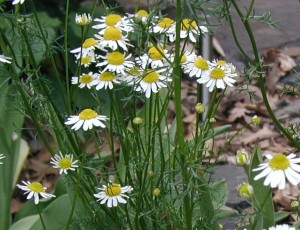The kitchen herbs have grown tall and some have already been harvested, like Chamomile. Just before the calendar says it’s summer, it’s time to harvest some herbs. We have peppermint, spearmint, oregano, thyme, lemon thyme, lemon balm, catnip and anise hyssop to harvest.
A great time to harvest herbs is right before they start flowering. It seems that the combination of plant chemicals changes during flowering and that means the scent and flavor of the herb will be altered, too. For example, basil attains a more spicy, astringent flavor after the plant flowers and that’s not what we like. To keep basil going strong and growing more leaves instead of flowers, pinch back the growing ends before the flowers are developed.
A few herbs we harvest as we need to use them. For one thing, some herbs like parsley and tarragon just don’t retain their scents very well upon drying. If there is an abundance of these herbs, a few springs will be cut, placed flat in freezer bags and zipped closed. Then, when needed all we have to do is take them from the freezer and snip off some parsley or tarragon. Freezing the herbs in this manner will retain much of their dark green color and much more of their fragrance – not to mention the good-for-you anti-oxidants – than drying them will.
Harvesting the herbs amounts to a few steps and it’s easy. After mid-morning or until about noon, the herbs will be cut with scissors, a sharp knife or pruners, depending on how thick the stems are. Don’t harvest first thing in the morning so that the moisture from the night air has had time to dissipate. Then, small bunches will be tied together and hung upside down to dry.
Alternatively, if there is a lot of plant material to dry, the herbs will be laid out on trays or newspaper in the shade. After a few hours the herbs will be turned over to allow all parts to dry. Turning will continue once or twice a day until the herbs are dry enough to be tied in bunches for hanging storage. Some herbs will have their leaves stripped from the stems and saved in glass jars for making teas.
